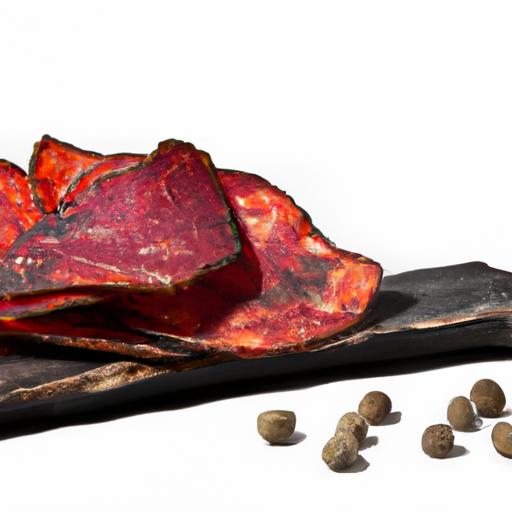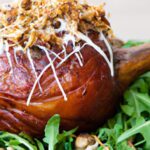In a world where nutrition meets convenience, high-protein jerky stands tall as the ultimate snack for fuel and flavor. Whether you’re an outdoor adventurer, a gym enthusiast, or simply someone craving a satisfying bite on the go, crafting the perfect jerky is an art-and a science. This guide dives deep into transforming simple strips of meat into protein-packed masterpieces, blending tradition with innovation. From selecting the right cut to mastering marination and drying techniques, get ready to unlock the secrets that turn humble jerky into a powerhouse snack tailored for your lifestyle. Welcome to your journey in becoming a jerky artisan!
Crafting the Perfect High-Protein Jerky: A Snack Maker’s Guide
Crafting the perfect high-protein jerky is an art that combines selecting the best cuts of meat with skillful marinating, drying, and storing techniques. Whether you’re craving a savory snack for hiking adventures or a protein-packed option for your busy lifestyle, homemade jerky offers unparalleled flavor and freshness. Let’s dive into the journey of transforming simple ingredients into a satisfyingly chewy, richly flavored delight that keeps you energized and craving more.
Prep and Cook Time
- Preparation: 20 minutes (plus 4-24 hours marinating)
- Drying Time: 4-8 hours depending on thickness and drying method
- Total Time: 5-32 hours
Yield
- Approximately 8 servings (2 oz per serving)
Difficulty Level
- Intermediate: Requires patience and attention to drying times for best texture and flavor balance.
Ingredients
- 2 lbs lean beef top round, partially frozen for easy slicing
- 1/4 cup soy sauce (low sodium)
- 2 tbsp Worcestershire sauce
- 1 tbsp honey or maple syrup
- 1 tsp smoked paprika
- 1 tsp black pepper, freshly ground
- 1/2 tsp garlic powder
- 1/2 tsp onion powder
- 1/4 tsp crushed red pepper flakes (optional for heat)
- 1 tbsp liquid smoke (optional for extra smokiness)
- Cooking spray or parchment paper for drying racks
Instructions
- Choose and prepare the meat: Start by trimming all visible fat from the top round as fat can spoil quickly. Slice into 1/8- to 1/4-inch thick strips against the grain for tenderness or with the grain for chewier jerky.
- Mix the marinade: In a large bowl, whisk together soy sauce, Worcestershire sauce, honey, smoked paprika, black pepper, garlic powder, onion powder, red pepper flakes, and liquid smoke until well combined.
- Marinate the strips: Submerge the beef strips in the marinade, ensuring each piece is fully coated. Cover and refrigerate for at least 4 hours, preferably overnight, to let the flavors deeply infuse the meat.
- Prepare for drying: Remove meat from marinade and pat dry with paper towels to reduce excess moisture-this step promotes even drying and prevents sogginess.
- Arrange strips on drying racks: Place meat strips in a single layer, without overlapping, on dehydrator trays or a wire rack set over a baking sheet. Lightly spray with cooking spray or line racks with parchment paper if needed to prevent sticking.
- Dry the jerky: Set your food dehydrator to 160°F (71°C) or your oven to the lowest setting (usually around 170°F/77°C). Dry for 4-8 hours, checking periodically. The jerky should be leathery, slightly pliable, and without any visible moisture when done.
- Cool and store: Allow jerky to cool completely on the racks before transferring to airtight containers or vacuum-sealed bags for longevity.
Tips for Success
- Cut selection: Opt for lean cuts like beef top round, sirloin, or eye of round to maximize protein while minimizing fat that can cause rancidity.
- Marinade balance: Adjust sweet, salty, and smoky elements to taste. For a bold twist, experiment with adding ground ginger or liquid smoke.
- Drying precision: Avoid drying at too high temperatures to prevent tough, brittle jerky. Patience yields the best chew and flavor.
- Testing doneness: Bend a piece; it should crack but not break immediately. Too soft means more drying required, too brittle means over-dried.
- Make ahead: Jerky stores well for weeks refrigerated, months frozen, or sealed with oxygen absorbers for extended shelf life.
Serving Suggestions
Enjoy your high-protein jerky on its own as a portable snack, or pair with sharp cheeses and crisp crackers for a gourmet twist. Garnish with fresh herbs like rosemary or thyme for an aromatic touch. For a trail-ready meal, include small packs of nuts and dried fruits alongside.

| Nutrient | Per 2 oz Serving |
|---|---|
| Calories | 160 |
| Protein | 24g |
| Carbohydrates | 3g |
| Fat | 4g |
For more expert tips, check out our Healthy Snacking Tips and learn how to incorporate jerky into a balanced diet. To deepen your knowledge on meat preservation, visit the USDA Food Safety and Inspection Service for trusted guidance on safe food handling.
Q&A
Q&A: Crafting the Perfect High-Protein Jerky – A Snack Maker’s Guide
Q1: Why choose jerky as a high-protein snack?
A1: Jerky isn’t just a snack; it’s a portable protein powerhouse! Packed with concentrated nutrition, it fuels your muscles, curbs hunger, and satisfies cravings without weighing you down. Whether you’re hiking, working, or just craving a savory treat, jerky blends convenience with nutrition seamlessly.
Q2: What types of meat are best for making high-protein jerky?
A2: Lean cuts are your go-to stars-think lean beef (like top round or sirloin), turkey breast, chicken breast, and even game meats such as venison. These choices offer a perfect balance of protein density with minimal fat, which is crucial for a chewy, flavorful jerky without extra grease.
Q3: How important is marinating, and what flavors work best?
A3: Marinating is the magic touch that transforms tough strips into tender, flavor-packed bites. A robust marinade balances salty, sweet, smoky, and spicy notes-soy sauce, Worcestershire, honey, garlic, and smoked paprika are classic ingredients. Let your meat bathe for at least 4-12 hours to soak up deep, mouthwatering character.
Q4: What’s the secret to perfect jerky texture?
A4: Patience and precision! Slice your meat thinly, consistently, and evenly against the grain to balance tenderness with chewiness. Dry it low and slow-usually around 160°F (71°C)-to prevent over-drying or toughness. The goal is a pliable snap, not cardboard!
Q5: Are there plant-based alternatives for high-protein jerky?
A5: Absolutely! Products crafted from soy, seitan, or mushrooms can be marinated and dried similarly. Experiment with bold marinades to mimic the savory, umami-rich flavors of traditional jerky, making for a delightful snack that’s kinder to the planet.
Q6: How do you safely store homemade jerky?
A6: Once dried completely and cooled, store your jerky in airtight containers or vacuum-sealed bags. Keep it in a cool, dark place or refrigerate for longer shelf life. Proper storage preserves flavor, texture, and safety-no one likes a stale chew!
Q7: Can I customize protein levels in my jerky?
A7: Yes! Starting with lean meat boosts protein per ounce. You can also blend meats or add protein-rich powders to marinades for a nutritional kick. Remember, the drying process intensifies protein concentration by removing moisture, naturally amplifying protein density.
Q8: What tools or equipment do I need to start making jerky at home?
A8: Equipment essentials include a sharp knife for precise slicing, a reliable dehydrator or an oven with a low-temperature setting, and airtight storage containers. A good meat thermometer is gold for ensuring safe drying temperatures. With these on hand, you’re ready to become a jerky artisan!
Crafting your own high-protein jerky is both an art and a science, blending flavors, textures, and nutrition into every chewy bite. With this guide in hand, you’re set to make snacking a deliciously wholesome adventure!
In Retrospect
As you embark on your jerky-making journey, remember that the perfect high-protein snack is as much about patience and precision as it is about passion. From selecting quality cuts to mastering the art of seasoning and drying, every step crafts not just jerky, but a personalized fuel that powers your day. Whether you’re hitting the trail, powering through workouts, or simply craving a savory boost, your homemade jerky will stand apart-rich in flavor, packed with protein, and tailored to your taste. So sharpen your knives, fire up your dehydrator, and let your creativity transform ordinary meat into extraordinary bites of nourishing delight. Happy snacking!


